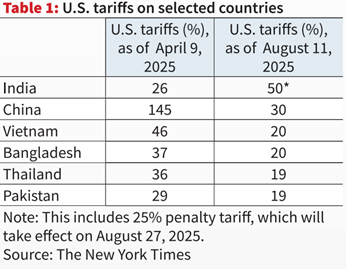

20th August 2025 (20 Topics)
Context:
In August 2025, the U.S. announced 50% tariffs on Indian imports, including a 25% penalty for India’s oil purchases from Russia.
Background: U.S. Tariff Measures
- Tariffs = taxes levied on imports; traditionally low in the U.S. (2–3% till 2024).
- April 2025: steep tariff hikes by the U.S. under President Trump.
- India targeted with 50% tariffs, higher than Vietnam or Bangladesh (?12%).
- Contrast: China, initially hit with 145% tariffs, later negotiated reduction to 30%.
Implications for India
- Economic Impact

- Loss of competitiveness: A $10 Indian shirt becomes $15 in the U.S., compared to $12 from Vietnam/Bangladesh.
- Export loss risk: U.S. is India’s largest export destination (textiles, pharma, IT).
- Widening trade deficit due to reduced dollar inflows.
- Employment and income loss in export-oriented sectors.
- Agricultural Market Pressure
- S. demands access for its dairy and agricultural products in exchange for tariff concessions.
- Potential harm to Indian farmers and dairy cooperatives.
Nature of China’s Influence
- Competitive edge: scale, infrastructure, technology.
- China’s global share:
- 36.3% in textiles & clothing,
- 24.9% in machinery/electrical equipment.
- India: 4.4% and 0.9% respectively.
- S.–China thaw due to China’s strategic role in supply chains (rare earths, electronics).
- Risk: tariff wars may divert global investments away from India.
Structural Challenges for India
- Over-reliance on low wages for competitiveness.
- Weakness in R&D and high-value sectors.
- Export base narrow compared to China’s diversified portfolio.
Shift in Global Demand Dynamics
- Western demand weakening due to ageing populations and inequality.
- Rising protectionism = less open markets.
- Future growth must be home-market-driven, not only export-led.
Role of India’s Youth
- India: world’s youngest workforce; 120 million youth (15–29 years) in education = equivalent to Japan’s population.
- Indian diaspora in the U.S.: 3.2 million (2023), disproportionately successful in tech, education, and innovation.
- Potential: shift from low-cost labour to knowledge and technology-based economy.
Way Forward
- Immediate Policy Options for India
- Diplomatic negotiations with the U.S. to seek tariff relaxation.
- Diversify export destinations: ASEAN, EU, Africa, West Asia.
- Countermeasures: calibrated tariffs on select U.S. products (without escalating trade war).
- Medium- to Long-term Strategies
- Enhance competitiveness: strengthen infrastructure, logistics, and technology adoption.
- Invest in R&D: pharmaceuticals, electronics, renewable energy.
- Protect domestic agriculture: resist U.S. dairy pressure by supporting cooperatives and nutrition-based domestic policies.
- Promote domestic demand: rising wages, job creation, and welfare spending (health, education).
- Skill development: harness youth bulge to move up global value chains.
- Leverage diaspora networks for technology and investment flows.
- Strategic Outlook
- India must avoid dependence on low-wage labour exports.
- Develop into a knowledge-driven, high-value economy with strong domestic demand.
- Youth and innovation must serve as strategic shields against global trade turbulence.

